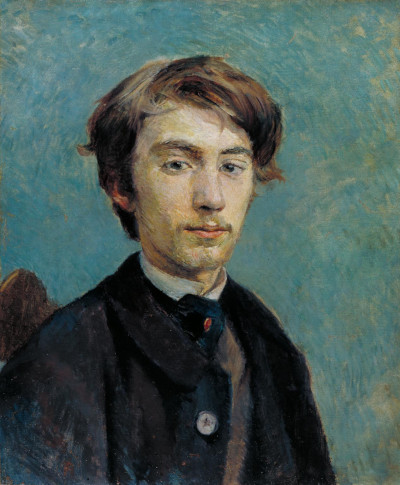This portrait by Henri Toulouse-Lautrec dates from 1885. The painting captures another artist, Emile Bernard, whilst he was studying at the Atelier Cormon, Paris in the late 19th century.
Emile is likely to have still been a teenager at the time of this painting and was studying alongside Henri and also Vincent van Gogh. Paris was the place to be for young artists at this time, with many exciting individuals from around Europe congregating here. They would tend to be within specific parts of the city, where they could live relatively cheaply and also find many other likeminded people with whom to exchange artistic ideas. Emile Bernard has been documented extensively and he is most remembered for his landscape paintings. He openly discussed this portrait too, and claimed there to have been as many as thirty different sittings for this piece alone, suggesting that Toulouse Lautrec was quite a particular artist. Even the fairly simple background took great depth of thought before being left as we see it today. There can be no doubt that the artist would want his friend to be both impressed and complemented by the work and perhaps that explains the slightly obsessive attention to detail that he used here.
Emile stares directly at us with a confident expression. His hair is slightly wavy, in part due to being grown out from its natural style. He sports a small beard which has been groomed carefully, making the best of what he could grow at that age. The artist wears a dark blue coat, with one button being particularly prominent. There is also a tie, shirt and perhaps a waist coat or vest just underneath. A small section of chair is visible behind the model but this is essentially a fairly simple composition. Lighting is fairly bright, with a good amount striking across the young man's face, though without any use of contrasting shadow. This gives the painting a fairly contemporary and positive look, with small dabs of paint still noticeable across the blue background. The slightly circular movement around his head is almost akin to the expressive nature of Van Gogh's work, though much more subtle in style.
This painting was acquired by the Tate in the UK in the 1960s. A British collector is known to have bequethed it to them, perhaps out of respect for being able to enjoy the rest of their collection during his own lifetime. Followers of the artist will sometimes make the trip to the museum set up in his name, which remains the best location from which to learn about his life and work. It is to be found in the south of France and remains a popular artistic venue. The artist's mother donated a large amount of her son's paintings to the institution back in the early 20th century and it continues to promote his impressive legacy all these years later.




